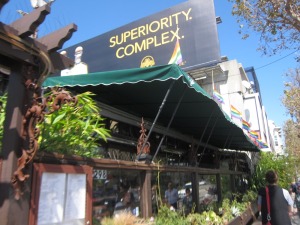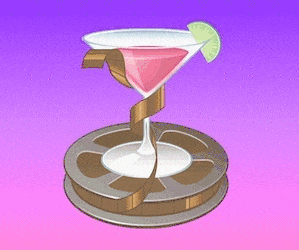 2298 Market Street
2298 Market Street
San Francisco, California 94114
(415) 621-8579
CafeFlore.com
Status: LGBT Restaurant/Bar
In Their Own Words: Cafe Flore, voted “Best Cafe” by readers of the SF Bay Guardian, Bay Area Reporter & SF Weekly in 2012, and “Best Well Drinks” in San Francisco by SF Weekly readers in 2010, has been the heart & soul of the Castro since 1973. A landmark all-ages cafe known for our distinctive brunch and dinner menus, sunny patio garden, full bar with great drink specials & community events, we proudly offer the most central meet up spot in the Castro, with a heated outdoor patio.
History
Summary
| Name | Dates of Operation |
| Cafe Flore | 1973 – present |
Details
Café Flore was built in 1973 by Alfred Finnila, chief iron worker for the construction of the Golden Gate Bridge who designed the Bridge Roadhouse which is now the Golden Gate Bridge’s visitor and gift center. It was built on land owned by the Finnila family that once housed the third location of the Finnila’s Finnish Baths, built by Alfred and his father, Matti Finnilia, which sprawled over into what is now the Market & Noe Center.
Matti Finnila emigrated from Finland to Los Angeles in 1902, and then to San Francisco after the 1906 earthquake to help rebuild the City. Finnila’s Finnish Baths first opened at 9 Douglass Street in the early 1910s as part of the Finnila family’s home before moving to 4032 17th Street near the corner of Market, Castro and 17th in 1919. It moved to the corner of Market and Noe in 1932. Later, after the construction of Café Flore in 1973 on what had been the pharmacy for Finnila’s Finnish Baths, the baths continued to occupy what is now the Market & Noe Center (still majority-owned by Alfred’s sister, Edna Jeffrey) until 1985, when it moved to the Sunset District as a women’s only club.
Mahmood and Ahmad Ghazi bought Café Flore in 1977 and owned it for the next 25 years. In 1982, the cult film Whatever Happened to Susan Jane? was filmed in part at the cafe.
J.D. Petras purchased Café Flore in 2002 from the original owners. Two years after he purchased it, he obtained a liquor license and, in a compromise with neighbors, curtailed hours of operation to end at 11:00 p.m. Sunday through Thursdays and midnight on weekends. His permit also allowed for extended operations during Pride and a few other special weekends.
In 2006, Café Flore began hosting charity fundraisers after the Edge cancelled theirs after declining to seek an Entertainment License. The café/bar sought to extend their hours, but neighbor opposition mired the plans.
In early 2007, Petras briefly put Café Flore on the market before instead deciding to pursue permits to be able to serve food 24 hours a day, extend his liquor license from midnight to 2:00 a.m., and have amplified music later at night. His goal with the extended operations was improve business by being able to host fundraisers that didn’t have to stop at midnight. Though some neighbors opposed the plans over noise concerns, the Planning Commission approved the permit in December of 2007, but limited the café’s use of sidewalk tables to 9:00 p.m. Sundays through Wednesdays and 11:00 p.m. the rest of the week, and required the outdoor patio be closed at 3:00 a.m. until the Commission could hold hearings nine months later about 24-hour outdoor service. Both the state Bureau of Alcohol Beverage Control and the city Entertainment Commission also had to approve the permit.
In February of 2013, the San Francisco Planning Commission voted 6-1 to approve Café Flore’s petition to operate a second off-site kitchen across the street in an apartment owned by Café Flore’s owner J.D. Petras. Former owners of the café who had lived in that apartment and covertly used their own kitchen to make soup stock and cut vegetables. Petras purchased the apartment with the same intent, working with the Department of Public Health to upgrade the apartment’s kitchen to meet commercial food safety standards. The SF Board of Supervisors ratified the Planning Commission’s recommendation in April.
In 2014, Petras brought in Stu Gerry and Brett Klinker as new managing partners, along with silent partner Pat McKune. Some of the changes include offering beer on tap rather than just bottles, and providing table service. Café Flore’s resigned DJ booth will pay homage to the Bridge Roundhouse, and the film Whatever Happened to Susan Jane? will be projected on the walls.
Readers of the Bay Area Reporter voted for Café Flore to win about half of the 2014 food categories in the paper’s annual competition, winning Best Brunch, Best Lunch, Best Restaurant with a Patio, Best View, Best Place for a First Date, and, perversely, Best Place for a Last Date.
Sources
Bajko, Matthew S., “Battle brews over café plans,” Bay Area Reporter, November 29, 2007.
Bajko, Matthew S., “Café, chain stores win reprieve,” Bay Area Reporter, December 13, 2007.
Bajko, Matthew S., “Online Extra: Political Notes: SF supes tackle Castro zoning issues,” Bay Area Reporter, April 18, 2013.
Bajko, Matthew S., “Planning Commission approves Café Flore’s off-site kitchen,” Bay Area Reporter, February 21, 2013.
Bajko, Matthew S., “Plans by café rile neighbors,” Bay Area Reporter, April 20, 2006.
de Jim, Strange, San Francisco’s Castro, Arcadia Publishing, 2003.
Leyland, Winston, Out in the Castro: Desire, Promise, Activism, Leyland Publications, 2002, 0-943595-88-6.
“New Partners at Cafe Flore Bringing Restorative Changes to the Historic Spot,” Tabblehopper, July 29, 2014.
Timberlake, Sean, “Besties: Eat the Best,” Bay Area Reporter, April 3, 2014.
Whatever Happened to Susan Jane?
Whiting, Sam, “Where History Was Made: A tour of 41 points of gay interest all across the city,” San Francisco Chronicle, June 23, 2000.
Location
2298 Market Street, San Francisco

Hi – I believe much of this, at least about the origins and early years is incorrect. https://www.facebook.com/groups/1449159615391140/posts/2964912647149155